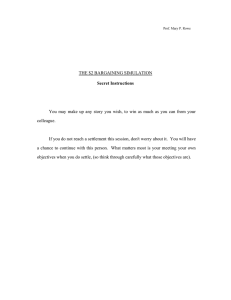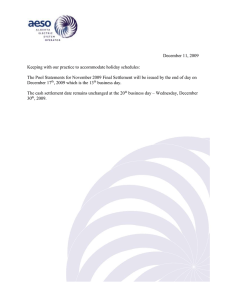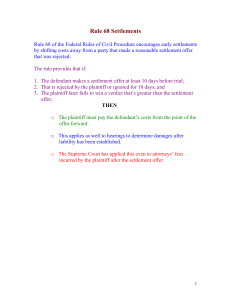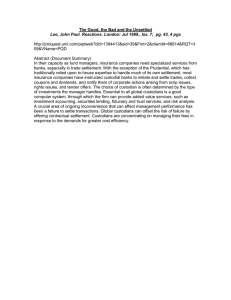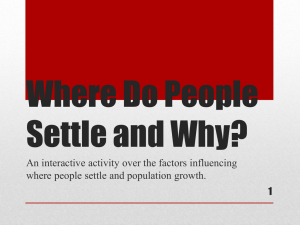Econ 522 Economics of Law Dan Quint Spring 2012
advertisement
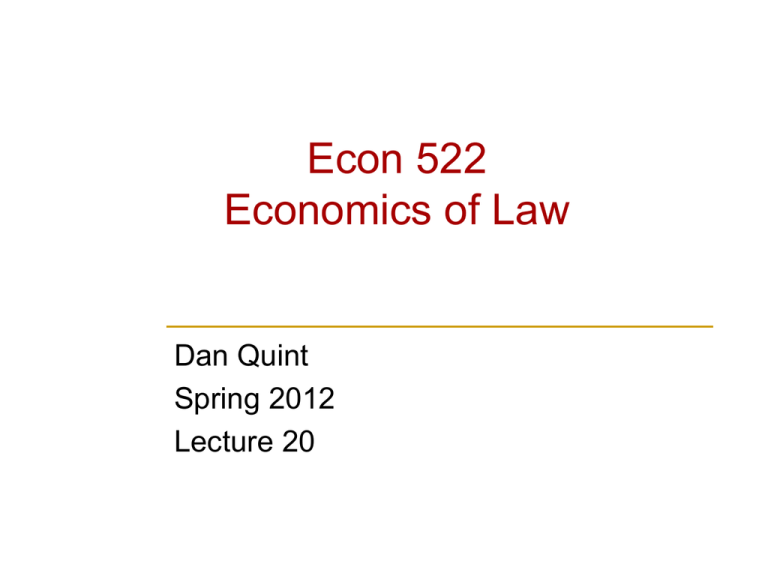
Econ 522 Economics of Law Dan Quint Spring 2012 Lecture 20 Discussion question – recapping tort law punish the choice punish the outcome • criminal law • strict liability rule • regulations Choice + Bad Luck Outcome punish the combination of choice and outcome • negligence rule QUESTION: What are the pros and cons of each approach? 1 Thinking about the legal process 2 Over the last three months, we have… Developed theories of property/nuisance law, contract law, and tort law Looked at how rules of legal liability create incentives Thought about how these rules can be chosen to try to achieve efficient outcomes 3 Over the last three months, we have… To achieve efficiency, we’ve generally tried to set a party’s liability equal to the harm he caused someone else Damages in nuisance law Expectation damages in contract law Compensatory damages in tort law That way, he internalizes the externality he imposes, leading to efficient decisions In doing this, we’ve been making two big assumptions: The legal system works flawlessly The legal system costs nothing 4 An example from Polinsky, “An Introduction to Law and Economics” I hit you with my car and did $10,000 worth of damage We both know I was negligent But courts aren’t perfect If we go to trial, 80% chance I’ll be found liable, 20% I won’t If I’m held liable, damages are correctly set at $10,000 So on average, if we go to trial, you expect to recover $8,000 But if we go to trial, we both have to hire lawyers Suppose this costs us each $3,000 Now your expected gain from going to trial is $8,000 – 3,000 = 5,000 And my expected cost is $8,000 + 3,000 = 11,000 5 An example from Polinsky, “An Introduction to Law and Economics” So… Going to trial gains you $5,000 (in expectation) Going to trial costs me $11,000 (in expectation) Maybe we can settle out of court If we avoid going to court and I pay you any settlement between $5,000 and $11,000, we’re both better off So maybe this happens But… 6 An example from Polinsky, “An Introduction to Law and Economics” Suppose I’m more pessimistic about my chances than you You think I’m 80% likely to be found liable I think I’m 90% likely to be found liable You think your expected gain is $8,000 – 3,000 = $5,000 I think my expected cost is $9,000 + 3,000 = $12,000 Now the range of possible settlements is even wider Any settlement between $5,000 and $12,000 is a Paretoimprovement over going to trial So settling is more likely 7 An example from Polinsky, “An Introduction to Law and Economics” Now instead, suppose I’m more optimistic about my chances than you You think I’m 80% likely to be found liable I think I’m only 10% likely to be found liable You think your expected gain is $8,000 – 3,000 = $5,000 I think my expected cost is $1,000 + 3,000 = $4,000 Now an out-of-court settlement is impossible There are no settlements that you and I would both agree to 8 An example from Polinsky, “An Introduction to Law and Economics” And, even if our beliefs are compatible and there are settlements that we would both prefer to trial… …private information might lead to failure to reach a settlement Remember from before: if our threat points are private information, we might fail to reach an agreement because each of us is holding out for too big a share So even if we had the same beliefs about what will happen at trial, private information could prevent settlement 9 An example from Polinsky, “An Introduction to Law and Economics” So when litigation is costly… If the two parties agree on the likely outcome of a trial, there are gains from settling out of court, and a range of settlements they would both prefer to going to trial If the two parties are relatively pessimistic, settlement is even more likely If the two parties are relatively optimistic, settlement may be impossible Even if the two have the same beliefs or are relatively pessimistic, private information may lead to failures in bargaining 10 So what? Under strict liability… We said injurers internalize cost of accidents efficient precaution But this assumes cost of being sued = damage done If courts are unpredictable and litigation is costly, private cost of being sued for damages could be > or < cost of accident Which could lead to too much or too little precaution But also… If settlement talks break down and cases go to trial… …then total social cost of an accident includes the harm done, and the resources expended during the trial! If trial costs $6,000, then social cost of the accident isn’t $10,000, but $16,000 – which increases the efficient level of precaution! 11 What is the goal of the legal process? Tort law: efficiency meant minimizing the total social cost of accidents Actual cost of accidents Plus cost of actions taken to prevent them (precaution) Goal of the legal process: minimize its social costs Direct (administrative) costs Error costs 12 Administrative costs and error costs Administrative costs Hiring judges, building courthouse, paying jurors… More complex process higher cost Error costs Any legal process is imperfect Errors are any judgments that differ from theoretically perfect ones An error in computing damages after the fact only affects distribution, not efficiency But anticipated errors affect incentives, which may lead to actions which aren’t efficient Error costs are costs of distortions in actions people take (precaution, activity levels, etc.) due to flaws in legal system 13 The goal of the legal process So theoretically, the efficient legal process is the one that minimizes the sum of… The direct costs of administering the system, and The economic effects of errors due to that process not being perfect 14 The legal process 15 The legal process Once an accident has happened… Victim could sue or not sue The victim and injurer might quickly settle out of court If the case proceeds to trial, the first step (in the U.S.) is a pre-trial exchange of information After that, victim and injurer might still settle out of court If the case goes to trial, victim (now plaintiff) might win or lose Losing side at trial can choose to appeal (or not) 16 Stages of the legal process… decision to pursue a legal claim bargaining over out-of-court settlements pre-trial exchange of information trial itself appeals process 17 Why sue? In a rational world, victim compares cost of filing a lawsuit to expected gain from suing How to calculate expected value of a legal claim? 18 Why sue? Harm done: $100 70% chance you settle immediately Sue? Don’t File File Average settlement is $50, legal costs of $1 Settle immediately or exchange info? “Discovery” Settle Discovery process costs $3.30 70% chance you settle after discovery, average settlement is $50, legal costs of $1 Settle then or go to trial? Settle Trial Win or lose at trial? Win Lose Trial costs $20 Plaintiff wins with probability 50%, damages = harm Appeal costs $20 Appeal? No Yes Win or Lose Appeal? Win Lose Appeal succeeds with probability 10%, damages = harm 19 Why sue? Harm done: $100 70% chance you settle immediately Sue? Don’t File File Average settlement is $50, legal costs of $1 Settle immediately or exchange info? “Discovery” Settle Discovery process costs $3.30 70% chance you settle after discovery, average settlement is $50, legal costs of $1 Trial costs $20 Plaintiff wins with probability 50%, damages = harm Appeal costs $20 Appeal succeeds with probability 10%, damages = harm Settle then or go to trial? Settle Trial Win $30 50% Win or lose at trial? Lose 50% Appeal? –$20 $100 – $20 = $80 No $0 Yes –$10 Win 10% $100 – $20 = $80 Win or Lose Appeal? Lose 90% –$20 20 Why sue? Harm done: $100 Sue? 70% chance you settle immediately Don’t File File Average settlement is $50, legal costs of $1 Settle immediately or exchange info? “Discovery” Settle Discovery process costs $3.30 70% * $49 + 30% * $30 = $43.30 70% chance you settle after discovery, average settlement is $50, legal costs of $1 Trial costs $20 Plaintiff wins with probability 50%, damages = harm Appeal costs $20 Appeal succeeds with probability 10%, damages = harm Settle then or go to trial? Settle Trial 70% $50 – $1 = $49 Win 30% Win or lose at trial? $30 Lose 50% 50% Appeal? –$20 $100 – $20 = $80 No $0 Yes –$10 Win 10% $100 – $20 = $80 Win or Lose Appeal? Lose 90% –$20 21 Why sue? Harm done: $100 70% chance you settle immediately Sue? Don’t File File Average settlement is $50, legal costs of $1 70% * $49 + 30% * $40 = $46.30 Settle immediately or exchange info? “Discovery” Settle Discovery process costs $3.30 70% chance you settle after discovery, average settlement is $50, legal costs of $1 70% $50 – $1 $43.30 –$43.30 $3.30 30% Settle then or go to trial? Settle Trial Win or lose at trial? Win Lose Trial costs $20 Plaintiff wins with probability 50%, damages = harm Appeal costs $20 Appeal? No Yes Win or Lose Appeal? Win Lose Appeal succeeds with probability 10%, damages = harm 22 Why sue? Harm done: $100 70% chance you settle immediately Average settlement is $50, legal costs of $1 Sue? Don’t File $0 File $46.30 $46.30 – filing costs Discovery process costs $3.30 70% chance you settle after discovery, average settlement is $50, legal costs of $1 Trial costs $20 Plaintiff wins with probability 50%, damages = harm Appeal costs $20 Appeal succeeds with probability 10%, damages = harm 23 Why sue? Sue? Don’t File $0 File $46.30 – filing costs Decision to sue If expected value of legal claim > filing costs, we expect victim to file a claim If expected value of legal claim < filing costs, we expect victim not to 24 Number of lawsuits So there are three things that directly influence the number of lawsuits The number of injuries The cost of filing a complaint The expected value of a claim Holding everything else constant… More injuries should mean more claims Holding fixed the number of accidents, lower filing costs, or higher expected value of claims, mean more claims But things can sometimes get more complicated… 25 Number of lawsuits Number of lawsuits not worth suing for most victims more precaution fewer accidents Typical level of damages 26 Filing costs Expected value of claims should vary widely Probability Filing Fee SUE DON’T SUE Expected value of claims 27 Filing costs Recall the efficient legal system minimizes the sum of administrative costs and error costs Higher filing fees fewer lawsuits lower administrative costs But, higher filing fees more injuries go “unpunished” greater distortion in incentives higher error costs Filing fee is set optimally when these balance on the margin: Marginal cost of reducing fee = marginal benefit Administrative cost of an additional lawsuit = error cost of providing no remedy in the marginal case 28 Filing costs Error costs If we’re only concerned with efficiency, we don’t care about distributional effects That is, we don’t care if a particular victim is or isn’t compensated So the size of error costs depends on how much peoples’ behavior responds to the incentives caused by liability “The social value of reducing errors depends on whether the errors affect production or merely distribution” When errors have large incentive effects, filing fees should be low When errors have small incentive effects, efficiency requires higher filing fees 29 Filing costs Probability Filing Fee SUE DON’T SUE Expected value of claims As long as there are any filing fees or other costs to litigation, some harms will be too low to justify a lawsuit When harm is small to each individual but large overall, one solution is a class action lawsuit 30 Class Action Lawsuits One or more plaintiffs bring lawsuit on behalf of a large group of people harmed in a similar way Example: California lawsuit over $6 bounced-check fee Court must “certify” (approve) the class Participating in a class-action suit eliminates victim’s right to sue on his own later If suit succeeds, court must then approve plaintiff’s proposal for dividing up the award among members of the class Class-action suits are desirable when individual harms are small but aggregate harms are large… Especially when avoidance of liability has strong incentive effect But there’s also a danger 31 Lawyers and clients Agency problem Client wants lawyer to work on case until marginal cost of more work equals marginal benefit This is hard to achieve through a contract, because lawyers face their own incentives One solution: 100% commission (client “sells lawsuit to lawyer”) But this is illegal Common solution: reputation 32 Stages of the legal process… decision to pursue a legal claim bargaining over out-of-court settlements pre-trial exchange of information trial itself appeals process 33 Exchange of Information Trials are costly to both parties If both parties agree on expected outcome of a trial, both are better off agreeing to out-of-court settlement on similar terms If two sides are relatively optimistic about their chances in court, this may be impossible After lawsuit filed but before trial, parties have opportunity to negotiate a settlement, and to exchange information relevant to trial Some information exchange is mandatory “Discovery” process in U.S. – each side must supply opponent with evidence they plan to use, answer questions about case In Europe, no pre-trial discovery; instead, first stage of trial involves similar sharing of information in front of judge Does voluntary pooling of information promote settlement? Does involuntary pooling of information promote settlement? 34 Voluntary exchange of information Parties tend to disclose information that corrects the other side’s relative optimism I hit you with my car I think your injuries were minor, damages might be $1,500 You know they were serious, have x-rays and doctor’s reports to prove it, know damages will be $15,000 Going to trial costs us each $3,000 As things stand: I expect trial to cost me $4,500; you expect to gain $12,000; settlement seems unlikely But you’re happy to show me your evidence Once I see it, I might offer a bigger settlement, we both avoid cost of trial Parties tend to withhold information that would correct other side’s relative pessimism Either way, voluntary exchange of information tends to 35 encourage settlement Voluntary exchange of information Cooter and Ulen: Trials occur when the parties are relatively optimistic about their outcome, so that each side prefers a trial rather than settlement on terms acceptable to the other side. When the parties are relatively optimistic, at least one of them is uninformed. Pooling of information before trial that reduces relative optimism promotes settlement. Furthermore, by revealing private information to correct the other side’s false optimism, the party making the disclosure increases the probability of settling on more favorable terms. 36 What about involuntary exchange of information? Involuntary disclosure will tend to reveal information the parties would otherwise choose to withhold This is usually information that corrects relative pessimism So forced disclosure may make settlement less likely On the other hand, involuntary disclosure reduces uncertainty, makes two sides’ threat points more clear May make reaching a settlement easier So overall effect is unclear Involuntary disclosure may also delay settlement until after disclosure occurs 37 What about involuntary exchange of information? Disclosure (“discovery”) rule in the U.S. very extensive Parties reveal basic arguments they’ll make, evidence that supports them, names of witnesses, nature of each witness’s testimony Each side can inspect other’s evidence, question its witnesses Witnesses or evidence not disclosed during discovery may not be allowed at trial Most European countries have little or no pre-trial discovery Europe: juries rarely used in civil cases Delays and interruptions less costly, more common Under civil law, judges take more active role in developing arguments and exploring evidence 38 Effect of information disclosure on administrative and error costs Voluntary disclosure encourages settlements Fewer trials, simpler/quicker trials lower administrative costs Settlement terms get closer to likely trial outcome; if this judgment would likely be correct, this reduces error costs Involuntary disclosure Might lead to more or fewer trials Should lead to simpler, shorter trials Discovery is also a costly process Overall effect on administrative costs could be positive or negative Pools much of the information that would come out at trial, so settlements should deviate less from trial outcomes So involuntary disclosure should reduce error costs 39 Stages of the legal process… decision to pursue a legal claim bargaining over out-of-court settlements pre-trial exchange of information trial itself appeals process 40 Pre-Trial Bargaining Plaintiff might accept settlements S when S > Expected JudgmentPlaintiff – Legal CostsPlaintiff Defendant might offer settlements S when S < Expected JudgmentDefendant + Legal CostsDefendant So settlement is possible when EJP – LCP < EJD + LCD which is when EJP – EJD < LCP + LCD degree of relative optimism combined legal costs 41 Pre-Trial Bargaining Suppose parties agree on expected judgment EJ If bargaining fails and case goes to trial, Plaintiff gets expected payoff EJ – LCplaintiff Defendant gets expected payoff – EJ – LCdefendant So these are threat points during bargaining Combined payoffs are – LCplaintiff – LCdefendant If settlement is reached, combined payoffs are 0 So gains from cooperation are LCplaintiff + LCdefendant If gains from cooperation are split evenly… Plaintiff’s payoff is (threat point) + ½ (gains) = (EJ – LCplaintiff) + ½ (LCplaintiff + LCdefendant) = EJ – ½ LCplaintiff + ½ LCdefendant 42 Pre-Trial Bargaining We just concluded… If the two parties agree on expected outcome of trial… …and successfully negotiate a settlement… …and divide gains from cooperation equally… then settlement = EJ – ½ LCP + ½ LCD If going to trial is equally costly to both parties, this is just EJ – the expected judgment at trial But if trial is more costly to defendant, this would be more 43 Nuisance Suits A nuisance suit is a lawsuit with no legal merit If it goes to trial, defendant will definitely win (EJ = 0) Sole purpose of a nuisance suit is to force a settlement Just found: “reasonable settlement” = EJ – ½ LCP + ½ LCD So if LCP = LCD, nuisance suit is pointless – reasonable settlement would be 0 But suppose going to trial is very costly for defendant Publicity would be bad for defendant’s reputation Or, developer has to settle lawsuit to avoid delaying construction LCP is just legal fees But LCD includes legal fees plus other costs So even if lawsuit has no merit, defendant might feel forced to pay 44 a settlement Nuisance Suits Example Cost of going to trial is $5,000 for defendant, $1,000 for plaintiff Expected judgment = 0 Threat points are -5,000 and -1,000 Gains from cooperation are 6,000 If gains are split evenly, plaintiff’s payoff is (threat point) + ½ (gains) = -1,000 + ½ (6,000) = 2,000 So nuisance suit might lead to a settlement of $2,000, even though expected judgment at trial is 0 45 Failures in negotiations Even without relative optimism, settlement negotiations may fail due to private information Ex: defendant made a faulty product, which injured lots of people Some sustained minor injuries, say $2,000 Some sustained major injuries, say $10,000 Before trial, defendant can’t tell scope of plaintiff’s injuries Suppose legal costs are $500 for each side If ½ of plaintiffs had major injuries, average injury = $6,000 So reasonably settlement offer might be $6,000 But if all defendants are offered a settlement of $6,000, the ones with minor injuries will take it, and the ones with major injuries will go to trial Defendant has two choices: Offer settlements large enough that everyone will accept But then even people with very minor injuries, or none, might sue Or offer only small settlements, and get stuck going to trial in many cases 46 Stages of the legal process… decision to pursue a legal claim bargaining over out-of-court settlements pre-trial exchange of information trial itself appeals process 47 Trial In Europe… Judges in civil trials take active role in asking questions and developing case “Inquisitorial system,” since judge asks questions In U.S… Lawyers’ job to develop case Judge is more of a passive referee “Adversarial system,” since competing lawyers are adversaries 48 Incentives Lawyers have a strong incentive to win at trial May be working on contingency Value reputation for winning Judges have no stake in outcome of the trial Judges will (we hope) generally do what is right… …but have less motivation to work hard “Judges have incentives to do what is right and easy; lawyers have incentives to do what is profitable and hard.” 49 Who pays the costs of a trial? In U.K., loser in a lawsuit often pays legal expenses of winner Discourages “nuisance suits” But also discourages suits where there was actual harm that may be hard to prove In U.S., each side generally pays own legal costs But some states have rules that change this under certain circumstances 50 Who pays the costs of a trial? Rule 68 of Federal Rules of Civil Procedure “At any time more than 10 days before the trial begins, a party defending against a claim may serve upon the adverse party an offer [for a settlement]… If the judgment finally obtained by the offeree is not more favorable than the offer, the offeree must pay the costs incurred after the making of the offer.” “Fee shifting rule” Example I hit you with my car, you sue Before trial, I offer to settle for $6,000, you refuse If you win at trial, but judgment is less than $6,000… …then under Rule 68, you would have to pay me for all my legal expenses after I made the offer 51 Who pays the costs of a trial? Rule 68 does two things to encourage settlements: Gives me added incentive to make a serious settlement offer Gives you added incentive to accept my offer But not actually as generous as it sounds Attorney’s fees not always included in fees that are covered Asymmetric Plaintiff is penalized for rejecting defendant’s offer Defendant is not penalized for rejecting offer from plaintiff 52 Who pays the costs of a trial? Kathryn Spier, “Pretrial Bargaining and the Design of FeeShifting Rules” Game-theory analysis of Rule 68 and similar rules Shows that when parties have private information, fee-shifting rules like this increase probability of settlement Then considers designing “perfect” rule to maximize number of cases that would settle out of court Ideal rule is similar to two-sided version of Rule 68 Take each side’s most generous settlement offer Compute a cutoff If eventual judgment is below this cutoff, plaintiff pays both sides’ legal fees; if above cutoff, defendant pays both sides’ fees 53 Unitary versus Segmented Trials Trial has to answer two questions: Is defendant liable? If so, how much are damages? Unitary trial considers liability and damages at same time Economies of scope Segmented trial considers liability first, then damages later (if necessary) Damages phase may not be necessary In U.S., judges have discretion over which type of trial 54 Burden of proof Burden of proof: who is responsible for showing what at trial In criminal case, prosecutor’s burden to show defendant is guilty, not defendant’s burden to show he’s innocent Similarly, in civil case, plaintiff’s burden to make case Under negligence rule, plaintiff has to prove defendant was negligent (rather than defendant having to show he was not) Under contributory negligence, once defendant is shown to be negligent, it’s defendant’s burden to show plaintiff was also negligent 55 Standard of proof Standard of proof: degree of certainty to which something must be shown in court In criminal cases, “beyond a reasonable doubt” – very high standard In civil cases, plaintiff usually has to prove case by “a preponderance of the evidence” Much lower standard – interpreted as anything over 50% certainty For punitive damages to be awarded, high standard of proof is often required: “clear and convincing evidence” Efficient level depends on relative costs of two types of errors Finding someone liable when they should not be Finding someone not liable when they should be 56 Rules of evidence Rules for what evidence court can pay attention to Textbook gives examples where rules seem inconsistent, if goal is simply to maximize probability of “right outcome” When we focus on efficiency, we care only about outcomes, not about process But in real-world legal system, process is important in its own right 57 Stages of the legal process… decision to pursue a legal claim bargaining over out-of-court settlements pre-trial exchange of information trial itself appeals process 58 Appeals In U.S., three levels of federal courts District courts, circuit courts of appeals, Supreme Court (Many state court systems also have three levels, but this varies by state) Parties in district court cases have right of appeal Circuit court is required to consider their appeal Parties in circuit court cases do not Supreme Court has discretionary review – chooses which cases to hear In common law countries, appeals courts tend to only consider certain issues Appeals generally limited to matters of law Matters of fact generally not considered 59 Appeals Recall goal of legal system Minimize administrative costs + error costs Clearly, appeals process increases administrative costs So only efficient if it reduces error costs Reasons why appeals process may reduce error costs Appeals courts are more likely to reverse “wrong” decisions than “right” decisions… …which leads to losing parties appealing more often when decision was “wrong” 60 Stages of the legal process… decision to pursue a legal claim bargaining over out-of-court settlements pre-trial exchange of information trial itself appeals process 61 Up next Up next: criminal law If you want to read ahead: Friedman chapter 15, or Becker paper 62
